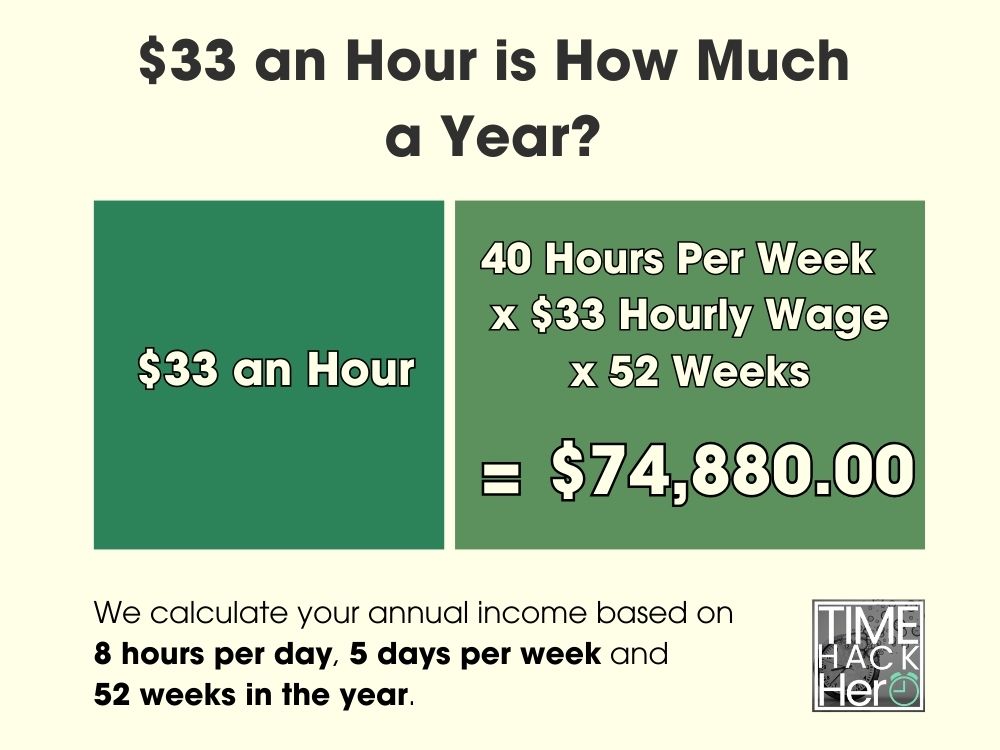With the cost of living continuing to rise, many workers are taking a close look at their hourly wages to determine if they can maintain their lifestyle. An hourly rate of $33 may initially sound high, but how much does it actually translate to as a weekly, monthly or yearly salary? And how much take-home pay can someone expect after deducting taxes?
In this article, we will calculate $33 per hour as a weekly, monthly and yearly salary before and after typical taxes and deductions. We’ll look at whether $33 an hour is considered a good wage in today’s economy, and what kind of lifestyle it could afford. To do this, we’ll create sample budgets to see if $33 an hour is enough to live comfortably, buy a car, or purchase a home. Understanding how an hourly or salaried pay structure works is key to making smart career and financial decisions. With proper planning, even an hourly wage can go far. We’ll also look at the impact of inflation on $33 an hour and provide tips for increasing your hourly earnings. Determining exactly what an hourly wage equals yearly and after taxes is crucial knowledge for anyone paid by the hour.
When you’re paid by the hour, it can be hard to figure out just how much your yearly income amounts to. After all, the number of hours you work each week and each year can vary quite a bit. But if you’re earning $33 an hour, there are some simple calculations you can do to estimate your potential annual earnings.
In this article, we’ll walk through the math step-by-step. We’ll look at how to calculate your income based on full-time and part-time work, and account for factors like overtime, holidays, and time off.
Whether you’re just starting a new job, considering a career change, or simply curious what your earning potential is, read on to find out the answer to the question: $33 an hour is how much a year?
Table of Contents
Convert $33 Per Hour to Weekly, Monthly, and Yearly Salary
Input your wage and hours per week to see how much you’ll make monthly, yearly and more.
$33 an Hour is How Much a Year?
If you make $33 an hour, your yearly salary would be $68,640. We calculate your annual income based on 8 hours per day, 5 days per week and 52 weeks in the year.
Hours worked per week (40) x Hourly wage($33) x Weeks worked per year(52) = $68,640
$33 an Hour is How Much a Month?
If you make $33 an hour, your monthly salary would be $5,720. We calculated this number by dividing your annual income by 12 months.
Hours worked per week (40) x Hourly wage($33) x Weeks worked per year(52) / Months per Year(12) = $5,720
$33 an Hour is How Much a Biweekly?
If you make $33 an hour, your biweekly salary would be $2,640.
Hours worked per week (40) x Hourly wage($33) x 2 = $2,640
$33 an Hour is How Much a Week?
If you make $33 an hour, your weekly salary would be $1,320. Calculating based on 5 days per week and 8 hours each day.
Hours worked per week (40) x Hourly wage($33) = $1,320
$33 an Hour is How Much a Day?
If you make $33 an hour, your daily salary would be $264. We calculated your daily income based on 8 hours per day.
Hours worked per day (8) x Hourly wage($33) = $264
$33 an Hour is How Much a Year?
The basic formula to calculate your annual salary from an hourly wage is:
Hourly Rate x Hours Worked per Week x Number of Weeks Worked per Year = Annual Salary
So for a $20 per hour job:
$33 per hour x 40 hours per week x 52 weeks per year = $68,640
However, this simple calculation makes some assumptions:
- You will work 40 hours every week of the year
- You will not get any paid time off
Therefore, it represents your earnings if you worked every week of the year, without any vacation, holidays, or sick days.
Accounting for Paid Time Off
The $68,640 base salary does not yet factor in paid time off (PTO). Let’s assume the job provides:
- 2 weeks (10 days) paid vacation
- 6 paid holidays
- 3 paid sick days
This totals 19 paid days off, or nearly 4 weeks of PTO.
Importantly, this paid time off should not be deducted from the annual salary, since you still get paid for those days.
So with 4 weeks PTO, the annual salary would remain $68,640 .
Part time $33 an hour is How Much a Year?
Your annual income changes significantly if you work part-time and not full-time.
For example, let’s say you work 30 hours per week instead of 40. Here’s how you calculate your new yearly total:
$33 per hour x 30 hours per week x 52 weeks per year = $51,480
By working 10 fewer hours per week (30 instead of 40), your annual earnings at $33 an hour drop from $68,640 to $51,480.
That’s a $17,160 per year difference just by working part-time!
Here’s a table summarizing how your annual earnings change depending on how many hours you work per week at $33 an hour:
| Hours Per Week | Earnings Per Week | Annual Earnings |
|---|---|---|
| 40 | $1,320 | $68,640 |
| 35 | $1,155 | $60,060 |
| 30 | $990 | $51,480 |
| 25 | $825 | $42,900 |
| 20 | $660 | $34,320 |
| 15 | $495 | $25,740 |
The more hours per week, the higher your total yearly earnings. But part-time work allows for more life balance if you don’t need the full salary.
$33 an Hour With Overtime is How Much a Year?
Now let’s look at how overtime can increase your annual earnings.
Overtime kicks in once you work more than 40 hours in a week. Typically, you earn 1.5x your regular hourly wage for overtime hours.
So if you make $33 per hour normally, you would make $49.50 per hour for any hours over 40 in a week.
Here’s an example:
- You work 45 hours in a Week
- 40 regular hours paid at $33 per hour = $1,320
- 5 overtime hours paid at $49.50 per hour = $247.50
- Your total one Week earnings =$1,320 + $247.50 = $1,567.50
If you worked 45 hours each week for 52 weeks, here’s how your annual earnings increase thanks to overtime pay:
$1,567.50 per week x 52 weeks per year = $81,510
That’s $12,870 more than you’d earn working just 40 hours per week at $33 an hour.
Overtime can add up! But also consider taxes and work-life balance when deciding on extra hours.
Here’s a table summarizing how your annual earnings change depending on how many hours you work per week at $33 an hour:
| Overtime hours per work day | Hours Per Week | Earnings Per Week | Annual Earnings |
| 0 | 40 | $1,320 | $68,640 |
| 1 | 45 | $1,567.50 | $81,510 |
| 2 | 50 | $1,815 | $94,380 |
| 3 | 55 | $2,062.50 | $107,250 |
| 4 | 60 | $2,310 | $120,120 |
| 5 | 65 | $2,557.50 | $132,990 |
| 6 | 70 | $2,805 | $145,860 |
| 7 | 75 | $3,052.50 | $158,730 |
How Unpaid Time Off Impacts $33/Hour Yearly Earnings
So far we’ve assumed you work 52 paid weeks per year. Any unpaid time off will reduce your total income.
For example, let’s say you take 2 weeks of unpaid leave. That brings your paid weeks down to 50:
Hours worked per week (40) x Hourly wage($33) x Weeks worked per year(50) = $66,000 annual salary
With 2 weeks unpaid time off, your annual earnings at $33/hour would drop by $2,640.
The table below summarizes how your annual income changes depending on the number of weeks of unpaid leave.
| Weeks of unpaid leave | Paid weeks per year | Earnings Per Week | Annual Earnings |
| 0 | 52 | $1,320 | $68,640 |
| 1 | 51 | $1,320 | $67,320 |
| 2 | 50 | $1,320 | $66,000 |
| 3 | 49 | $1,320 | $64,680 |
| 4 | 48 | $1,320 | $63,360 |
| 5 | 47 | $1,320 | $62,040 |
| 6 | 46 | $1,320 | $60,720 |
| 7 | 45 | $1,320 | $59,400 |
Key Takeaways for $33 Hourly Wage
In summary, here are some key points on annual earnings when making $33 per hour:
- At 40 hours per week, you’ll earn $68,640 per year.
- Part-time of 30 hours/week results in $51,480 annual salary.
- Overtime pay can boost yearly earnings, e.g. $12,870 extra at 45 hours/week.
- Unpaid time off reduces your total income, around $2,640 less per 2 weeks off.
- Your specific situation and location impacts taxes and PTO.
Knowing your approximate annual salary and factors impacting it makes it easier to budget and plan your finances. The next step is calculating take-home pay after deductions like taxes.
$33 An Hour Is How Much A Year After Taxes
Figuring out your actual annual earnings based on an hourly wage can be complicated once taxes are taken into account. In addition to federal, state, and local income taxes, 7.65% of your gross pay also goes to Social Security and Medicare through FICA payroll taxes. So how much does $33 an hour equal per year after FICA and income taxes are deducted from your gross pay?
Below we’ll walk through the steps to calculate your annual net take home pay if you make $33 per hour. This will factor in estimated federal, FICA, state, and local taxes so you know exactly what to expect.
Factoring in Federal Income Tax
Your federal income tax will be a big chunk out of your gross pay. Federal tax rates range from 10% to 37%, depending on your tax bracket.
To estimate your federal income tax rate and liability:
Look up your federal income tax bracket based on your gross pay.
2023 tax brackets: single filers
| Tax rate | Taxable income bracket | Tax owed |
|---|---|---|
| 10% | $0 to $11,000. | 10% of taxable income. |
| 12% | $11,001 to $44,725. | $1,100 plus 12% of the amount over $11,000. |
| 22% | $44,726 to $95,375. | $5,147 plus 22% of the amount over $44,725. |
| 24% | $95,376 to $182,100. | $16,290 plus 24% of the amount over $95,375. |
| 32% | $182,101 to $231,250. | $37,104 plus 32% of the amount over $182,100. |
| 35% | $231,251 to $578,125. | $52,832 plus 35% of the amount over $231,250. |
| 37% | $578,126 or more. | $174,238.25 plus 37% of the amount over $578,125. |
For example, if you are single with $68,640 gross annual pay, your federal tax bracket is 22%.
Your estimated federal tax would be:
$5,147 + ($68,640 – $44,726) x 22% = $10,408.08
So at $33/hour with $68,640 gross pay, you would owe about $10,408.08 in federal income taxes.
Considering State Income Tax
In addition to federal tax, most states also charge a state income tax. State income tax rates range from about 1% to 13%, with most falling between 4% and 6%.
Key Takeaways
-
- California, Hawaii, New York, New Jersey, and Oregon have some of the highest state income tax rates.
- Alaska, Florida, Nevada, South Dakota, Tennessee, Texas, Washington, and Wyoming don’t impose an income tax at all.
- Another 10 U.S states have a flat tax rate—everyone pays the same percentage regardless of how much they earn.
A State-by-State Comparison of Income Tax Rates
| STATE | TAX RATES | LOWEST AND HIGHEST INCOME BRACKETS |
|---|---|---|
| Alaska | 0% | None |
| Florida | 0% | None |
| Nevada | 0% | None |
| South Dakota | 0% | None |
| Tennessee | 0% | None |
| Texas | 0% | None |
| Washington | 0% | None |
| Wyoming | 0% | None |
| Colorado | 4.55% | Flat rate applies to all incomes |
| Illinois | 4.95% | Flat rate applies to all incomes |
| Indiana | 3.23% | Flat rate applies to all incomes |
| Kentucky | 5% | Flat rate applies to all incomes |
| Massachusetts | 5% | Flat rate applies to all incomes |
| New Hampshire | 5% | Flat rate on interest and dividend income only |
| North Carolina | 4.99% | Flat rate applies to all incomes |
| Pennsylvania | 3.07% | Flat rate applies to all incomes |
| Utah | 4.95% | Flat rate applies to all incomes |
| Michigan | 4.25% | Flat rate applies to all incomes |
| Arizona | 2.59% to 4.5% | $27,806 and $166,843 |
| Arkansas | 2% to 5.5% | $4,300 and $8,501 |
| California | 1% to 13.3% | $9,325 and $1 million |
| Connecticut | 3% to 6.99% | $10,000 and $500,000 |
| Delaware | 0% to 6.6% | $2,000 and $60,001 |
| Alabama | 2% to 5% | $500 and $3,001 |
| Georgia | 1% to 5.75% | $750 and $7,001 |
| Hawaii | 1.4% to 11% | $2,400 and $200,000 |
| Idaho | 1.125% to 6.5% | $1,568 and $7,939 |
| Iowa | 0.33% to 8.53% | $1,743 and $78,435 |
| Kansas | 3.1% to 5.7% | $15,000 and $30,000 |
| Louisiana | 1.85% to 4.25% | $12,500 and $50,001 |
| Maine | 5.8% to 7.15% | $23,000 and $54,450 |
| Maryland | 2% to 5.75% | $1,000 and $250,000 |
| Minnesota | 5.35% to 9.85% | $28,080 and $171,221 |
| Mississippi | 0% to 5% | $5,000 and $10,001 |
| Missouri | 1.5% to 5.3% | $1,121 and $8,968 |
| Montana | 1% to 6.75% | $2,900and $17,400 |
| Nebraska | 2.46% to 6.84% | $3,340 and $32,210 |
| New Jersey | 1.4% to 10.75% | $20,000 and $1 million |
| New Mexico | 1.7% to 5.9% | $5,500 and $210,000 |
| New York | 4% to 10.9% | $8,500 and $25 million |
| North Dakota | 1.1% to 2.9% | $41,775 and $458,350 |
| Ohio | 0% to 3.99% | $25,000 and $110,650 |
| Oklahoma | 0.25% to 4.75% | $1,000 and $7,200 |
| Oregon | 4.75% to 9.9% | $3,750 and $125,000 |
| Rhode Island | 3.75% to 5.99% | $68,200 and $155,050 |
| South Carolina | 0% to 7% | $3,110 and $15,560 |
| Vermont | 3.35% to 8.75% | $42,150 and $213,150 |
| Virginia | 2% to 5.75% | $3,000 and $17,001 |
| Washington, D.C. | 4% to 9.75% | $10,000 and $1 million |
| West Virginia | 3% to 6.5% | $10,000 and $60,000 |
| Wisconsin | 3.54% to 7.65% | $12,760 and $280,950 |
To estimate your state income tax:
Look up your state income tax rate based on your gross pay and filing status.
Multiply your gross annual pay by the state tax rate.
For example, if you live in Pennsylvania which has a flat 3.07% tax rate, your estimated state tax would be:
$68,640 gross pay x 3.07% PA tax rate = $2,107.25 estimated state income tax
So with $68,640 gross annual income, you would owe around in $2,107.25 Pennsylvania state income tax. Verify your specific state’s income tax rates.
Factoring in Local Taxes
Some cities and counties levy local income taxes ranging from 1-3% of taxable income.
To estimate potential local taxes you may owe:
- Check if your city or county charges a local income tax.
- If yes, look up the local income tax rate.
- Multiply your gross annual pay by the local tax rate.
For example, say you live in Columbus, OH which has a 2.5% local income tax. Your estimated local tax would be:
$68,640 gross pay x 2.5% local tax rate = $1,716 estimated local tax
So with $68,640 in gross earnings, you may owe around $1,716 in Columbus local income taxes. Verify rates for your own city/county.
Accounting for FICA Taxes (Social Security & Medicare)
FICA taxes are a combination of Social Security and Medicare taxes that equal 15.3% of your earnings. You are responsible for half of the total bill (7.65%), which includes a 6.2% Social Security tax and 1.45% Medicare tax on your earnings.
In 2023, only the first $160,200 of your earnings are subject to the Social Security tax
There is an additional 0.9% surtax on top of the standard 1.45% Medicare tax for those who earn over $200,000 (single filers) or $250,000 (joint filers).
To estimate your FICA tax payment:
$68,640 x 6.2% + $68,640 x 1.45% = $5,250.96
So you can expect to pay about $5,250.96 in Social Security and Medicare taxes out of your gross $68,640 in earnings.
Total Estimated Tax Payments
Based on the examples above, your total estimated tax payments would be:
Federal tax: $10,408.08
State tax: $2,107.25
Local tax: $1,716
FICA tax: $5,250.96
Total Estimated Tax: $19,482.29
Calculating Your Take Home Pay
To calculate your annual take home pay at $33 /hour:
1. Take your gross pay
2. Subtract your estimated total tax payments
$68,640 gross pay – $19,482.29 Total Estimated Tax = $49,157.71 Your Take Home Pay
n summary, if you make $33 per hour and work full-time, you would take home around $49,157.71 per year after federal, state, local , FICA taxes.
Your actual net income may vary depending on your specific tax situation. But this gives you a general idea of what to expect.
Convert $33 Per Hour to Yearly, Monthly, Biweekly, and Weekly Salary After Taxes
If you make $33 an hour and work full-time (40 hours per week), your estimated yearly salary would be $68,640 .
The $68,640 per year salary does not account for taxes. Federal, state, and local taxes will reduce your take-home pay. The amount withheld depends on your location, filing status, dependents, and other factors.
Just now during our calculation of $33 An Hour Is How Much A Year After Taxes, we assumed the following conditions:
- You are single with $68,640 gross annual pay, your federal tax bracket is 22 %.
- You live in Pennsylvania which has a flat 3.07% tax rate
- You live in Columbus, OH which has a 2.5% local income tax.
In the end, we calculated your Total Estimated Tax is $19,482.29 , Your Take Home Pay is $49,157.71 , Total tax rate is 28.38%.
So next we’ll use 28.38% as the estimated tax rate to calculate your weekly, biweekly, and monthly after-tax income.
$33 Per Hour to Yearly, Monthly, Biweekly, Weekly,and Week Salary After Taxes Table
| Income before taxes | Estimated Tax Rate | Income Taxes | After Tax Income | |
| Yearly Salary | $68,640 | 28.38% | $19,482.29 | $49,157.71 |
| Monthly Salary | $5,720 | 28.38% | $1,623.52 | $4,096.48 |
| BiWeekly Salary | $2,640 | 28.38% | $749.32 | $1,890.68 |
| Weekly Salary | $1,320 | 28.38% | $374.66 | $945.34 |
$33 an hour is how much a year after taxes
Here is the adjusted yearly salary after a 28.38% tax reduction:
-
- Yearly salary before taxes: $68,640
- Estimated tax rate: 28.38%
- Taxes owed (28.38% * $68,640 )= $19,482.29
- Yearly salary after taxes: $49,157.71
| Hourly Wage | Hours Worked Per Week | Weeks Worked Per Year | Total Yearly Salary | Estimated Tax Rate | Taxes Owed | After-Tax Yearly Salary |
|---|---|---|---|---|---|---|
| $33 | 40 | 52 | $68,640 | 28.38% | $19,482.29 | $49,157.71 |
$33 an hour is how much a month after taxes
To calculate the monthly salary based on an hourly wage, you first need the yearly salary amount. Then divide by 12 months.
-
-
- Yearly salary before taxes at $33 per hour: $68,640
- Divided by 12 months per year: $68,640 / 12 = $5,720 per month
-
The monthly salary based on a 40 hour work week at $33 per hour is $5,720 before taxes.
After applying the estimated 28.38% tax rate, the monthly after-tax salary would be:
-
- Monthly before-tax salary: $5,720
- Estimated tax rate: 28.38%
- Taxes owed (28.38% * $5,720 )= $1,623.52
- Monthly after-tax salary: $4,096.48
Monthly Salary Based on $33 Per Hour
| Hourly Wage | Yearly Salary | Months Per Year | Before-Tax Monthly Salary | Estimated Tax Rate | Taxes Owed | After-Tax Monthly Salary |
|---|---|---|---|---|---|---|
| $33 | $68,640 | 12 | $5,720 | 28.38% | $1,623.52 | $4,096.48 |
$33 an hour is how much biweekly after taxes
Many people are paid biweekly, meaning every other week. To calculate the biweekly pay at $33 per hour:
- Hourly wage: $33
- Hours worked per week: 40
- Weeks per biweekly pay period: 2
- $33 * 40 hours * 2 weeks = $2,640 biweekly
Applying the 28.38%estimated tax rate:
- Biweekly before-tax salary: $2,640
- Estimated tax rate: 28.38%
- Taxes owed (28.38% * $2,640 )= $749.32
- Biweekly after-tax salary: $1,890.68
Biweekly Salary at $33 Per Hour
| Hourly Wage | Hours Worked Per Week | Weeks Per Pay Period | Before-Tax Biweekly Salary | Estimated Tax Rate | Taxes Owed | After-Tax Biweekly Salary |
|---|---|---|---|---|---|---|
| $33 | 40 | 2 | $2,640 | 28.38% | $749.32 | $1,890.68 |
$33 an hour is how much weekly after taxes
To find the weekly salary based on an hourly wage, you need to know the number of hours worked per week. At 40 hours per week, the calculation is:
- Hourly wage: $33
- Hours worked per week: 40
- $33 * 40 hours = $1,320 per week
Accounting for the estimated 28.38% tax rate:
- Weekly before-tax salary: $1,320
- Estimated tax rate: 28.38%
- Taxes owed (28.38% * $1,320 )= $374.66
- Weekly after-tax salary: $945.34
Weekly Salary at $33 Per Hour
| Hourly Wage | Hours Worked Per Week | Before-Tax Weekly Salary | Estimated Tax Rate | Taxes Owed | After-Tax Weekly Salary |
|---|---|---|---|---|---|
| $33 | 40 | $1,320 | 28.38% | $374.66 | $945.34 |
Key Takeaways
- An hourly wage of $33 per hour equals a yearly salary of $68,640 before taxes, assuming a 40 hour work week.
- After accounting for an estimated 28.38% tax rate, the yearly after-tax salary is approximately $49,157.71 .
- On a monthly basis before taxes, $33 per hour equals $5,720 per month. After estimated taxes, the monthly take-home pay is about $4,096.48 .
- The before-tax weekly salary at $33 per hour is $1,320 . After taxes, the weekly take-home pay is approximately $945.34 .
- For biweekly pay, the pre-tax salary at $33 per hour is $2,640 . After estimated taxes, the biweekly take-home pay is around $1,890.68 .
Understanding annual, monthly, weekly, and biweekly salary equivalents based on an hourly wage is useful when budgeting and financial planning. Taxes make a significant difference in take-home pay, so be sure to account for them when making income conversions. Use this guide as a reference when making salary calculations.
What Is the Average Hourly Wage in the US?
Last Updated: Sep 1 2023
US Average Hourly Earnings is at a current level of $33.82, up from 33.74 last month and up from 32.43 one year ago. This is a change of 0.24% from last month and 4.29% from one year ago.
Average Hourly Earnings is the average dollars that a private employee makes per hour in the US. This metric is a part of one of the most important releases every month which includes unemployment numbers as well. This is normally released on the first Friday of every month. This metric is released by the Bureau of Labor Statistics (BLS).
What is the average salary in the U.S.?
Last Updated: July 18, 2023
The U.S. Bureau of Labor Statistics uses median salary data rather than averages to avoid skewed numbers from outlying high and low numbers. Median weekly earnings of the nation's 121.5 million full-time wage and salary workers were $1,100 in the second quarter of 2023, the U.S.
If a person works 52 weeks in the year, then this represents a national annual salary of $57,200.
Is $33 an Hour a Good Salary?
Whether $33 an hour is a good salary really depends on your location, expenses, and career field. The national median hourly wage in the U.S. is around $20 per hour. So an hourly pay rate of $33 is well above what the typical American worker makes. However, the cost of living varies dramatically across different states and cities.
For example, $33 an hour equals an annual salary of about $68,640 if you work 40 hours per week for 52 weeks. In lower cost rural areas and smaller metro areas, this salary would be considered solidly middle class or even upper-middle class. However, if you live in a high cost major city like New York or San Francisco, this salary may only afford a middle class or even working class standard of living.
The type of job also makes a difference. For lower skilled work that doesn’t require extensive education or training, $33 per hour would be an excellent wage. But for professional careers that require graduate degrees and extensive experience, like doctors, lawyers, and engineers, this hourly rate would be quite low.
So whether or not $33 an hour is considered a good wage depends heavily on your location, expenses, job type, and experience level. Compared to national averages it’s a good rate, but in high cost cities it may only be average or mediocre for middle class living.
Jobs that pay $33 an hour
While not common, there are a variety of jobs across industries and career fields that pay approximately $33 per hour:
- Skilled trade jobs: Electricians, plumbers, HVAC technicians
- Transportation jobs: Pilots, railroad engineers, some transit workers
- Public sector jobs: Police officers, fire fighters, registered nurses
- Technology jobs: Web developers, computer programmers, IT professionals
- Financial jobs: Accountants, actuaries, financial analysts
- Teachers and professors: High school teachers and adjunct professors with advanced degrees and experience
- Skilled manufacturing jobs: Power plant operators, electrical equipment assemblers
The most common jobs that pay $33 an hour require some type of formal training or certification, but not always a 4-year college degree. Many are technical skilled trade type jobs. Areas like tech, finance, and public sector jobs require higher education and more extensive qualifications.
Overall, an hourly salary of $33 is definitely on the higher end for fields that don’t require extensive qualifications like a graduate or professional degree. However, it’s considered average or even low for jobs requiring multiple advanced degrees or licenses. Geographic location also heavily impacts the value of $33/hour.
Can You Live Off $33 An Hour?
Whether or not $33 an hour provides a livable wage depends mostly upon the cost of living in your city and your personal lifestyle. For a single person without children, $33 an hour can provide a reasonably comfortable middle class lifestyle in most areas of the country. However, for families with kids, especially in high cost metropolitan areas, it would likely be considered lower middle class or working class.
According to the MIT Living Wage Calculator, the minimum required living wage for a single adult in the U.S. is around $16-20 per hour, depending on location. So $33 an hour is well above the minimum in most areas. However, the living wage for one working adult supporting a spouse and two children ranges from $28-44 per hour. So in high cost cities like San Francisco and New York, $33 an hour may not suffice as a “living wage” for a whole family.
In moderate or low cost areas of the country, $33 an hour provides a living wage even for families, allowing for decent housing, food, transportation, and healthcare costs. But in expensive urban regions, high housing costs in particular make it harder to live off this wage, especially for multi-person households. Cost of living calculators can provide estimates for specific cities.
For a single person, $33 an hour can certainly provide a comfortable standard of living almost anywhere in the U.S. But supporting a whole family at this wage would require strict budgeting, particularly in major metro areas.
The impact of inflation on the value of $33 an hour
With inflation rates hitting 40 year highs in 2022, the real value of $33 an hour has rapidly declined. High inflation erodes purchasing power and lowers real wages. When the annual inflation rate is 8-9% as it has been recently, a wage of $33 an hour loses over $2.50/hour in real value over a 12 month period.
For example, if you were making $33 an hour in September 2021, one year later in September 2022 your real hourly wage is only about $30.50 in purchasing power. But your nominal wage is still $33, so you have effectively gotten a pay decrease due to inflation exceeding wage growth.
This means $33 an hour in 2023 does not go nearly as far as it did even in 2021 or 2022. As the cost of goods and services rises far faster than wages, your real income declines. Everything from groceries, gas, rent, clothing, dining out, and other living expenses become pricier over time with high inflation.
Unless your wages receive cost of living or inflationary adjustments regularly, inflation silently but steadily eats away at your real earnings. This is why so many workers have seen their quality of life decline in 2022 despite normal pay raises.
To maintain the real value of $33/hour, hourly pay would need to increase to around $36/hour after an 8% inflation period. So if your earnings do not rise at least as fast as inflation, your purchasing power and living standard slowly diminishes.
5 Ways To Increase Your Hourly Wage
If you are currently earning around $33 per hour, there are some steps you can take to try to increase your hourly pay rate:
- Ask for a raise – If you are a strong performer, highlight your accomplishments and make the case for why you deserve higher pay to your manager.
- Get an advanced degree – Earning a master’s or other advanced degree can qualify you for higher paying roles.
- Pick up new skills – Take on training and certifications relevant to your industry that make you more valuable.
- Switch companies – Changing jobs is one of the fastest ways to boost your earnings.
- Negotiate higher pay – When interviewing or accepting a job offer, negotiate firmly and push for the highest pay possible. Consider things like signing bonuses and base salary rather than just hourly wage.
- Work overtime – Taking on extra overtime hours can substantially increase your total weekly or monthly earnings.
- Lower expenses – Cutting fixed costs in areas like housing, transportation, and insurance frees up more of your income.
With the right moves, in many career fields it’s possible to increase your hourly earnings from around $33 up to $35-40+ per hour over a few years. This requires proactive efforts through education, training, job changes, negotiations, and seeking promotions.
Buying a car on $33 an hour
Is it feasible to buy a decent quality car if you make $33 an hour? The answer depends on a few factors, but generally, yes you can afford a respectable used car on this hourly wage in most areas.
According to experts, your total vehicle expenses – including loan payments, insurance, gas and maintenance – should be below 15-20% of your gross monthly income. If you work full-time that would give you around $800 – $1,100 per month to spend on a vehicle.
This means with an income of $33 an hour, you can realistically afford car loan payments of $300 – $450 per month. That price range could allow you to finance a lightly used compact or mid-sized sedan from a few years ago, potentially in the $15,000 – $22,000 range depending on factors like down payment, interest rate, and loan term. You could also buy a newer economy car or certified pre-owned model and stay within budget.
While you may need to purchase an older used vehicle and get a longer loan term like 6 years, it is certainly possible to reliably finance a solid used car on $33 an hour without overextending your budget as long as you shop carefully. But brand new cars or large SUVs/trucks would likely be out of reach unless you save up a sizable down payment and keep the loan term shorter.
Maintaining full insurance coverage and budgeting for gas and periodic maintenance costs is also essential when buying a vehicle at this wage level. Overall, buying a car on $33 an hour is generally affordable, but requires sticking to used models and sensible loan terms to keep payments manageable.
Can You Buy a House on $33 An Hour?
Is buying a home achievable if you make $33 an hour? While not necessarily easy, if you live in an average or lower cost region, it is possible with the right planning and budgeting. Buying a home on this hourly wage will likely require some compromises.
The primary challenge is saving up enough for a sufficient down payment while also meeting the debt-to-income ratios most mortgage lenders require. But with good financial habits, buying a modest starter home or condo on $33 an hour is feasible. Here are some tips:
- Save aggressively – Set a budget that allows you to save 15% or more of your monthly take home pay so you can build up a down payment fund.
- Lower other debts – Pay down credit cards, auto loans, and student loans to keep your DTI ratio lower.
- Consider down payment assistance – Look into first-time buyer and low-income programs that help with the down payment.
- Buy below your preapproval amount – Get preapproved for a higher amount than you plan to spend to keep monthly costs very affordable.
- Improve your credit – Work on getting your credit score to at least 740, ideally over 760. This gets the best mortgage rates.
- Choose a modest home – Focus on affordable but livable starter homes, condos or townhomes to keep the price low. Consider fixer-uppers.
With diligent savings, limited existing debts, and a government assisted down payment, buying a home on $33 an hour is challenging but attainable. The keys are living within your means, budgeting thoroughly, and being willing to compromise on features and space initially.
Example Budget For $33 Per Hour
Here is an example monthly budget for someone earning $33 per hour while working full-time:
- Gross Monthly Income (pre-tax): $5,720
- Federal & State Taxes: $700
- Social Security, Medicare, Insurance: $350
- Net Take Home Pay: $4,670
- Rent (1 bedroom apartment): $1,200
- Groceries: $400
- Car Payment: $320
- Car Insurance: $120
- Gas: $150
- Health Insurance: $250
- Entertainment: $200
- Dining Out: $200
- Other bills (utilities, wifi, subscriptions): $300
- Total Monthly Expenses: $3,140
- Remaining: $1,530
- Emergency savings goals: $500
- Retirement savings goals: $500
- Leftover / Flex Spending Money: $530
This allows for a comfortable standard of living but requires sticking to a budget. There is limited wiggle room for big vacations, shopping sprees, or luxury expenditures without accumulating debt. This budget reflects living in an average cost of living metro area as a single person. Savings goals are crucial for future plans like buying a house.
In a high cost major city like San Francisco or NYC, that $1,200 rent would likely jump to $2,000+ and make saving and maintaining this budget much harder. In lower cost regions of the Midwest or South, that rent could potentially decrease to $800-1000, increasing leftover income. So location is key when determining actual spending power.
In Summary
Overall, an hourly wage of $33 is considered a strong rate compared to national averages, but may be only mediocre depending on your job type and geographic area. It provides a comfortable living for single adults in most areas, but families and those in high cost cities will find it harder to live and save on this salary alone.
The recent uptick in inflation also hinders the purchasing power of $33 per hour compared to previous years. With mindful budgeting and reasonable housing expenses, a $33 hourly wage allows a middle class lifestyle with limited luxuries for singles and couples without kids. But raising a family at this pay rate would require strict budgeting, particularly in expensive metro regions.
While achievable, buying a home on this wage also necessitates financial diligence and moderate expectations. With strategic saving and borrowing, you can buy a modest starter home or condo in most areas. Overall, $33 an hour provides a livable wage for moderate lifestyles in average cost of living areas, but is not high enough for lavish living or large families, especially in major high cost cities. Careful spending and saving is necessary to make ends meet and achieve financial goals over time.










